Kannoura is a small, out-of-the-way area in Shikoku, which is itself an out-of-the-way part of Japan. It’s the kind of place that could easily escape your attention if, say, you spaced out for a couple of minutes while driving past.
There are no tall buildings, no neon lights, few tourists, no shopping malls. Most food is fresh from the sea or locally grown, without chemicals; much of the natural scenery remains unspoiled; the people are genuinely warm and happy, the pace of their daily routines reflecting hard work, a strong sense of community, and more than anything else…inner peace.
It is, in short, my kind of place.
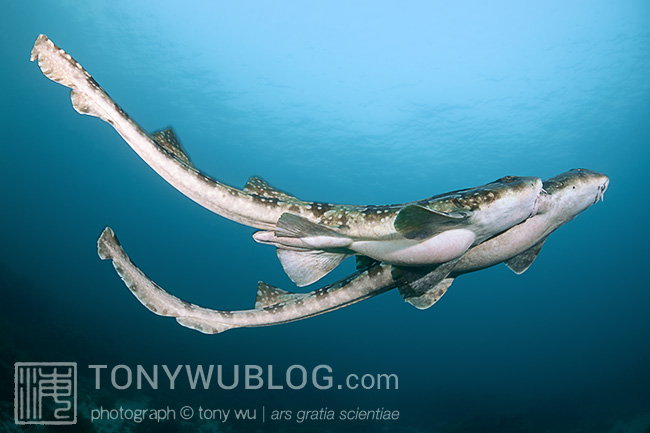
Whitespotted Bamboo Shark Mating Mystery
What took me to this remote, rustic community was the prospect of photographing bamboo sharks, specifically, the courtship and mating ritual of whitespotted bamboo sharks (Chiloscyllium plagiosum).
As far as sharks go, this species isn’t among the most charismatic or highest-impact, like great whites, tigers, hammerheads and such. Bamboo sharks are docile, easily kept in aquaria, and don’t inspire hair-raising adrenaline spikes like some of their more media-savvy cousins.
Truth be told, when I first heard about these sharks, I wasn’t all that interested.
My recent sojourn to Kannoura had its origins some 18 months ago, after I gave a presentation in Osaka in October 2012. During dinner and (a few too many) drinks after my talk, Fukui-san, whom I had only just met, showed me a brief video clip on his iPhone of a pair of whitespotted bamboo sharks mating. He had taken the video in May 2011, in the bay just outside his dive shop.
It was certainly interesting, but pursuing sharks isn’t really so much my thing these days, so I didn’t ascribe much importance to it.
Until I got home, that is.
It is my habit to search online for background information for just about everything I come across but am not familiar with. The Internet is a huge library, and I make liberal use of it, even for subjects I may not have immediate interest in.
Usually, my late-night search-engine forays end with the satisfaction of whatever limited curiosity I might have had; in some cases though, one thing leads to another, and I find myself with a new obsession (as if I really need any more of those).
When I started looking into Chiloscyllium plagiosum, it soon became apparent that there isn’t a lot of information available about these sharks in the wild. As I mentioned earlier, these accommodating cartilaginous fish are great for keeping in aquaria. As such, a lot of what we know about them comes from captive observation.
Most notably, the whitespotted bamboo shark’s claim to fame, at least for the general public, was the occurence of virgin birth at the Belle Isle Aquarium of the Detroit Zoological Institute in 2002.
In short, a female whitespotted bamboo shark that had never had contact with a male of its species laid eggs and produced several viable offspring, through a form of asexual reproduction called parthogensis. (Background information) (Update 17 January 2017: Another case of shark parthogenesis, this time in Stegostoma fasciatum)
Interest piqued, I looked for photos, research papers, anything I could find about the reproduction of these sharks in the wild. Try as I might, I could find no photos of mating behaviour for this species in their natural environment.
I was only able to find one bit of repeatedly-referenced information from a 2006 research paper (1), which put forth that mating of this species takes place during December and January in Taiwan, with ovulation in March through May (suggesting that perhaps the females can store sperm for later use). The research was based on observation in captivity and measuring the gonad mass of captured sharks.
The thing is, Fukui-san’s video of mating whitespotted bamboo sharks in Kannoura was from May, not December/ January, and from what he told me, depositing of fertilised eggs by the females that visit the waters of Kannoura seems to take place shortly after mating, not months later.
Thus the mating mystery materialised.
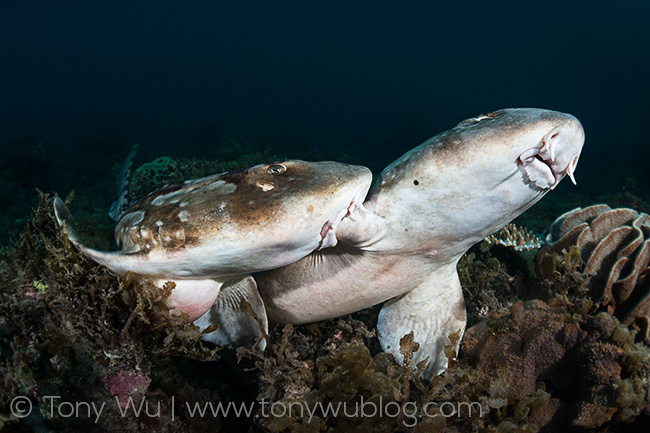
I immediately got in touch with Fukui-san to confirm what I remembered from our inebriated discussion.
Yup, the mating was in May. Yes, there was only one male and one female involved. Yes, he had seen related activity at the same time every year for many years. Yes, he thought it feasible for me to try to photograph the behaviour, and more importantly, he would be happy to help.
A lot has happened since October 2012, but I finally made it over to Kannoura this month, and with the benefit of Fukui-san’s knowledge, experience and hospitality, I was able to observe and photograph the entire courtship and mating sequence of whitespotted bamboo sharks.
Observing Chiloscyllium plagiosum Mating in the Wild
I’ve kept in continous contact with Fukui-san since we met, and while I was in Palau last month, I learned from him that the sharks were showing up at the expected time.
There are a number of reasons why having on-the-ground (or in-the-water) intel from Fukui-san was critical.
-
First, the sharks aren’t always in the shallow water bay at Kannoura. They spend the rest of the year some place else (no one is sure where) and seem to show up specifically for reproduction. They hang around for a few weeks, do their thing and then make themselves scarce again.
-
Though the timing is usually in May, nature does what nature wants to do. Traveling all the way to Shikoku only to find out the sharks weren’t there would be a world-class bummer.
-
At this time of year, the water temperature is about 19ºC (roughly 66ºF). It’s much more civilised to sip green tea at home than jump into the water myself to check what’s going on.
For my part…I had set aside the entirety of May for the purpose of trying to photograph these sharks mating. I was prepared both to wait at home for the green light from Fukui-san, and also to devote whatever time necessary on location to get the images I wanted.
I was determined. Dedicated. In for the long haul. Ready to suffer as long as it took. Weeks, the whole month if necessary. Slog my way through June as well if that’s what it took. I steeled myself for a contest-of-wills with the bamboo sharks. A proverbial test of my patience, tenacity, endurance.
In the end, it only took seven dives to nail the shots. Go figure.
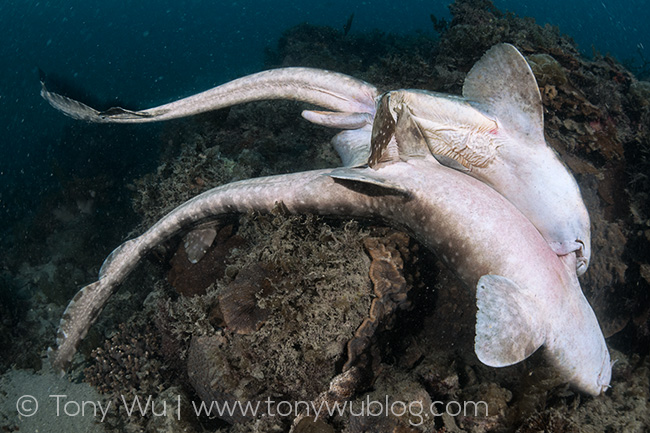
Fukui-san gave me the thumbs-up on 5 May, suggesting that the following week might afford the greatest chance for success. I arrived on 9 May, did a test dive on 10 May (it had been seven years since I had donned my cold-water gear), followed by a couple more dives on Sunday to get comfortable with my gear and familiarise myself with the aquatic terrain.
By Monday the 12th, we had spotted a handful of mature males (judging by the size of their claspers), as well as a couple of large females that looked as if they might be ready to mate.
Then came Tuesday, 13 May…which was my birthday.
As we headed out in the morning, I had a heart-to-heart with the ocean. I asked for a birthday present. You can probably guess what my request was.
Almost too good to be true…I came across an active male shortly after we hit the water. He was thrashing about, making quite a fuss while trying to work his way into a small area under a covered ledge to gain access to a large female.
Both Fukui-san and I thought “This is it!”
We high-fived and waited.
For whatever reason, the male stopped what he was doing after a few minutes, went into reverse gear, backed out of the hole, sat there for a while looking rather forlorn, then left.
“Noooooooooooooooooooo!!!!!!!!!!!!!!!!!!!!!!!!!” I groaned.
I followed the male around for nearly an hour, hoping he might make his way back for another attempt. I tried talking to him, bolstering his ego, offering him inter-species advice on the ways of love. All to no avail.
My hopes of seeing this male and female mate had been crushed. I was crestfallen.
I ended that dive disheartened and despondent, imagining that the male would find the same female or another one shortly after I exited the water, and I’d miss the main event.
Fukui-san and his partner Sayuri-san kindly found ways of distracting me for a few hours (i.e., feeding me), and we hit the water again in the late afternoon.
As the bubbles cleared, I looked down. Literally just below us was the same male, at the same hole, with the same female!!!
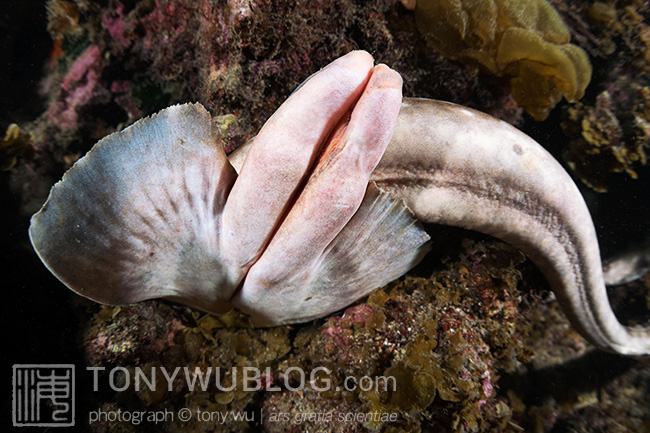
I waited for over two hours (boy was it cold!) before the male finally decided to act, working his way into the crevice, as pictured above. It was a tight fit, but he eventually wormed his way in and managed to secure a firm grip on the female’s pectoral fin by biting it, thereby initiating courtship.
In response, the female flailed and writhed as if struggling to escape. In the confines of the limited space, there wasn’t much room for the female to manoeuvre though.
The sharks eventually exited, with the female leading the male on an extended swim that lasted about an hour and covered a lot of ground. The female swam with periodic bursts of speed among coral heads, through seaweed, over areas of sand…coming to rest from time to time, but never for long.
Through the whole ordeal, the male held tight, refusing to let go, even when the female made rapid, jerky U-turns without warning.
Perhaps this is reading too much into the situation, but it sure looked to me like the female was testing the male. Though it’s difficult to generalise from just this one experience, I’d guess that had the female successfully shaken the male at any point, she would’ve taken off at high speed, leaving the male in her wake to nurse his broken pride.
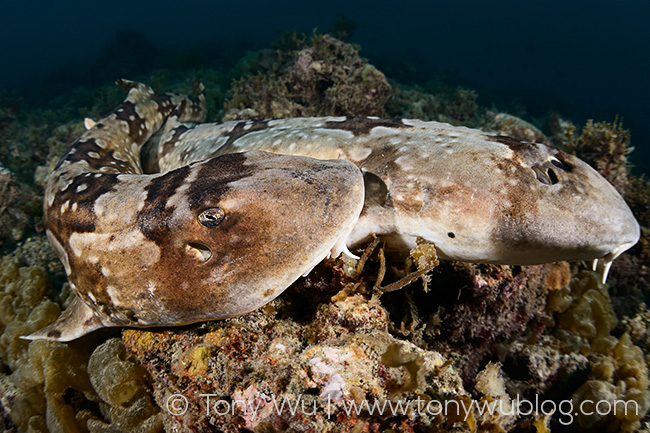
Eventually, the female relented. There was a momentary change in body language that was obvious even to me. She communicated her acceptance to the male, and the male wasted no time pinning her to the reef and getting down to business.
Once the process started, the female no longer tried to get away. The male continued thrashing about though, mostly it seemed to ensure optimal positioning.
Copulation lasted just over five minutes.
At the end, the male literally collapsed onto the sand from what seemed like exhaustion + satisfaction, not moving at all, while the female bolted away at high speed, clearly not interested in hanging around for a post-coital chat (…resisting tempation to draw parallels to H. sapiens).
It was just past 19:00 by the time the action ended. It was dark. I was alone. Fukui-san had run low on air and gone back to ensure that he’d be able to find me with the boat when I eventually surfaced (with fist raised in the air, hooting and whooping like a complete fish-geek idiot, as usual).
By the time all was said and done, the dive had lasted over 3.5 hours (with one change of air tank at about the two-hour mark); I had swum many hundreds of metres; and I knew I had the photos.
When we got back to the dock and unloaded our gear, a humongous(!) fireworks show lit up the sky just outside the harbour (there was a local festival we didn’t know about). We gawked at the impressive display for a half hour or more, cleaned up, and had a delicious celebratory meal Sayuri-san had prepared from the freshest of local ingredients, chased down with a smooth local shochu made from chestnuts (yummy!).
What a wonderful birthday it was.
Miscellaneous Thoughts and Information
I liked Kannoura and the surrounding area so much that I stayed on for five days after getting the photos. New friends took me to see beautiful mountains, forests, rivers, farms, beaches, wildlife and more.
I met local government officials for informal chats about possible future projects. And the local elementary school gave me the opportunity to give a talk to the kids of the community (more about this in a later post).
I was so busy in fact that I didn’t have any time to look through photos or to reflect upon what I had experienced until after I had left the area.
Once I hit the road to head back home though, I was able to take a closer look at my images and also Fukui-san’s video from May 2011. I noticed/ remembered a few things, and also came up with more questions.
-
The male I photographed was the same male that was in Fukui-san’s video from May 2011. I figured this out by comparing the pattern of spots on the sharks’ bodies, which I’ve worked out can be used to ID individual sharks. Comparing the dots on the male I photographed and the dots on the male in Fukui-san’s video made for a perfect match!
-
Seeing that the same male was in the same place to mate both in 2011 and 2014 made me wonder whether these sharks are territorial, or perhaps have some affinity to a specific place for reproduction. Also, it occurred to me that with sharks as amenable to being approached as these, and with the limited area in Kannoura they seem to use for reproduction, it should be possible to photo-ID and track individuals over multiple years, perhaps gaining more insight into their reproductive behaviour.
-
The females that this particular male mated with in 2011 and 2014 were not the same though, again based on comparing body patterns.
-
In the days before photographing the mating, we noticed some freshly deposited egg sacs that were empty. According to Fukui-san, when these empty egg sacs start to appear, the chances of seeing mating take place increase. Perhaps females depositing empty eggs are “warming up” in a sense? Or perhaps this is somehow related to the pheromones or whatever other signal the females use to communicate readiness to mate?
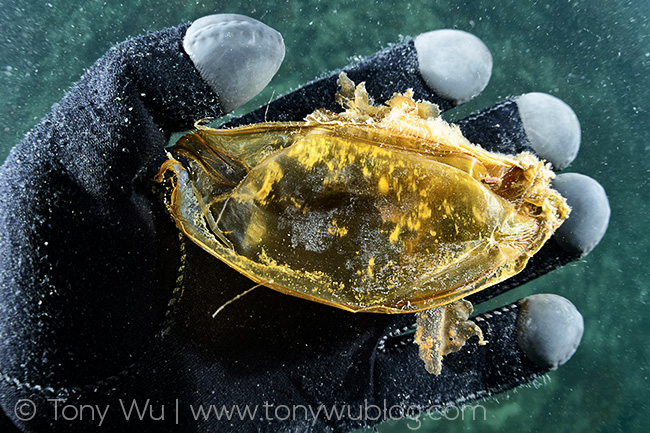
-
While I was following the male and female that I photographed mating, the female did manage to lose the male briefly once, hiding in a crevice. Though the male could not see her, he managed to track her down very quickly, almost as if by “sniffing” her out. He appeared to lock on to a scent (for lack of a better word) and make a beeline for her hideout.
-
Also of interest, although there were other males in the immediate vicinity, some that appeared sexually mature, we did not see any other males pursue this female or attempt to cut-in once the action had started. There was certainly enough commotion to alert any nearby male sharks paying attention. This seems unusual in the shark world, as mating among other shark species often seems to be a lotsa-boys-on-one-female scenario. The one-on-one nature of Chiloscyllium plagiosum mating in this area has been consistent through every encounter Fukui-san has had. Why would other males not compete for the right to mate with a receptive female, especially if they had aggregated in the area specifically for reproduction? How do they establish which one gets to mate, and which one gets to mate with which female? Is there a dominant male that gets more opportunities to mate?
-
The timing of mating for these sharks is different from that referenced in the research paper from Taiwan. Could mating behaviour be location-specific? Also, that research suggested the possibility of females storing the sperm for a while before laying eggs. In Kannoura at least, this doesn’t seem to happen. The females seem to lay eggs immediately. In fact, deposits of fertilised eggs are appearing now in Kannoura, with fetal development taking place from now and juveniles emerging from eggs sacs in August and September.
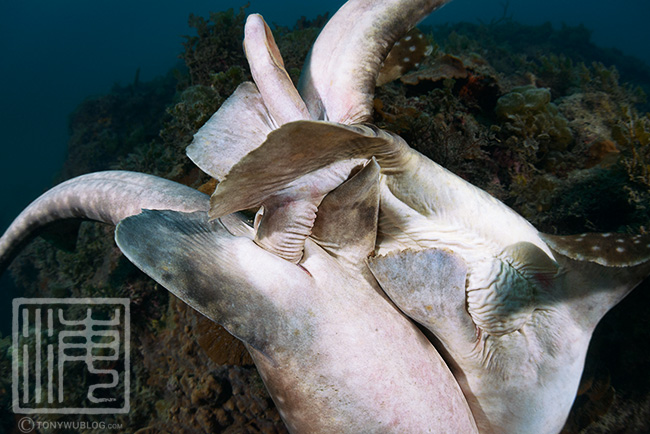
In many cases, like this one, success observing/ figuring out/ documenting something can lead to additional questions and more puzzles. I suppose that’s the fun and challenge of working with nature. There’s always something else to think about.
To wrap up, I owe a huge “Thank you!” to my wonderful hosts Fukui-san and Sayuri-san, as well as to everyone else in Kannoura and the surrounding areas who were so welcoming and helpful.
Thank you so, so much, and I hope that I’ll have the good fortune of visiting you again soon!
心から感謝します。すごく楽しい経験でした。是非、近いうちに甲浦にまた行きたいです!
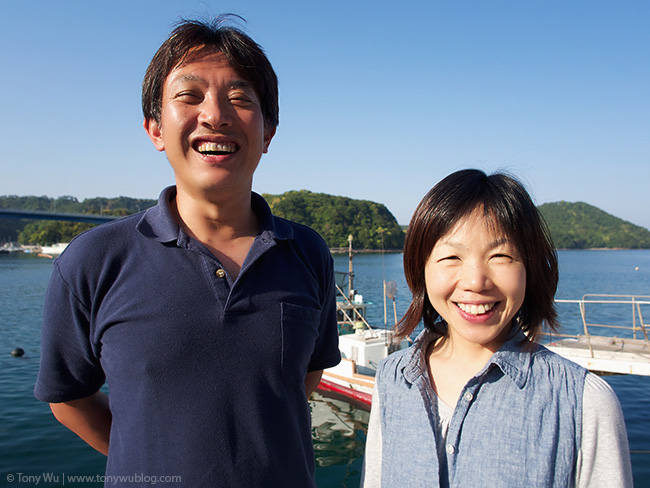
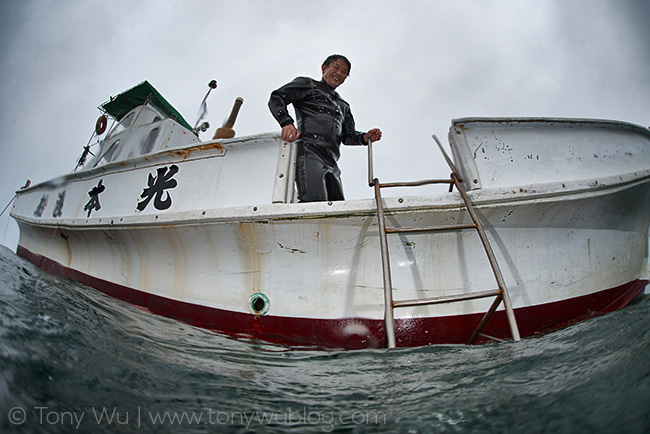

(1) Chen, W.K. and Liu, K.M. (2006) Reproductive biology of whitespotted bamboo shark Chiloscyllium plagiosum in northern waters off Taiwan. Fisheries Science, 72: 1215–1224 (Go back to main text.)